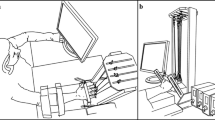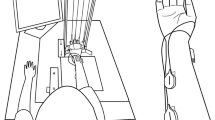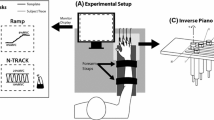Abstract
The purpose of this study was to test the principle of motor abundance, which has been hypothesized as the principle by which the central nervous system controls the excessive degrees of freedom of the human movements, in contrast to the traditional negative view of motor redundancy. This study investigated the changes in force stabilizing and moment stabilizing synergies for multi-finger pressing tasks involving different number of fingers. Twelve healthy subjects produced a constant pressing force while watching visual feedback of the total pressing force for the fingers involved in each task. Based on the principle of motor abundance, it was hypothesized that the multi-finger synergies for the total force stabilizing synergy and the total moment stabilizing synergy would be greater as the number of task finger increases. Force stabilizing and moment stabilizing synergies were quantified using the framework of the uncontrolled manifold analysis. It was found that strong force stabilizing synergies existed for all the finger combinations. The index of force stabilizing synergies was greater when the task involved more number of fingers. The index of moment stabilizing synergies was negative for the two-finger combination, representing moment destabilizing synergies. However, the index of moment stabilizing synergies was positive for three-finger and four-finger combinations, representing strong moment stabilizing synergies for these finger combinations. We interpret the findings as an evidence for the principle of abundance for stabilization of both, total force as well as total moment.




Similar content being viewed by others
References
Bernstein N (1967) The co-ordination and regulation of movements. Pergamon, Oxford
Danion F, Schoner G, Latash ML, Li S, Scholz JP, Zatsiorsky VM (2003) A mode hypothesis for finger interaction during multi-finger force-production tasks. Biol Cybern 88:91–98
de Freitas SM, Scholz JP, Stehman AJ (2007) Effect of motor planning on use of motor abundance. Neurosci Lett 417:66–71
Gelfand IM, Latash ML (1998) On the problem of adequate language in motor control. Mot Control 2:306–313
Goodman SR, Latash ML (2006) Feed-forward control of a redundant motor system. Biol Cybern 95:271–280
Goodman SR, Shim JK, Zatsiorsky VM, Latash ML (2005) Motor variability within a multi-effector system: experimental and analytical studies of multi-finger production of quick force pulses. Exp Brain Res 163:75–85
Gorniak SL, Zatsiorsky VM, Latash ML (2007) Hierarchies of synergies: an example of two-hand, multi-finger tasks. Exp Brain Res 179:167–180
Hsu WL, Scholz JP, Schoner G, Jeka JJ, Kiemel T (2007) Control and estimation of posture during quiet stance depends on multijoint coordination. J Neurophysiol 97:3024–3035
Kang N, Shinohara M, Zatsiorsky VM, Latash ML (2004) Learning multi-finger synergies: an uncontrolled manifold analysis. Exp Brain Res 157:336–350
Kapur S, Friedman J, Zatsiorsky VM, Latash ML (2010) Finger interaction in a three-dimensional pressing task. Exp Brain Res 203:101–118
Kelso JA, Tuller B (1984) Converging evidence in support of common dynamical principles for speech and movement coordination. Am J Physiol 246:R928–R935
Latash M (2000) There is no motor redundancy in human movements. There is motor abundance. Mot Control 4:259–260
Latash ML, Zatsiorsky VM (2009) Multi-finger prehension: control of a redundant mechanical system. Adv Exp Med Biol 629:597–618
Latash ML, Scholz JP, Danion F, Schoner G (2001) Structure of motor variability in marginally redundant multifinger force production tasks. Exp Brain Res 141:153–165
Latash ML, Scholz JP, Danion F, Schoner G (2002) Finger coordination during discrete and oscillatory force production tasks. Exp Brain Res 146:419–432
Latash ML, Shim JK, Smilga AV, Zatsiorsky VM (2005) A central back-coupling hypothesis on the organization of motor synergies: a physical metaphor and a neural model. Biol Cybern 92:186–191
Latash ML, Scholz JP, Schoner G (2007) Toward a new theory of motor synergies. Mot Control 11:276–308
Liu D, Todorov E (2007) Evidence for the flexible sensorimotor strategies predicted by optimal feedback control. J Neurosci 27:9354–9368
Macpherson JM, Rushmer DS, Dunbar DC (1986) Postural responses in the cat to unexpected rotations of the supporting surface: evidence for a centrally generated synergic organization. Exp Brain Res 62:152–160
Oliveira MA, Shim JK, Loss JF, Petersen RD, Clark JE (2006) Effect of kinetic redundancy on hand digit control in children with DCD. Neurosci Lett 410:42–46
Santello M, Flanders M, Soechting JF (1998) Postural hand synergies for tool use. J Neurosci 18:10105–10115
Scholz JP, Schoner G (1999) The uncontrolled manifold concept: identifying control variables for a functional task. Exp Brain Res 126:289–306
Scholz JP, Danion F, Latash ML, Schoner G (2002) Understanding finger coordination through analysis of the structure of force variability. Biol Cybern 86:29–39
Scholz JP, Schöner G, Hsu WL, Jeka JJ, Horak F, Martin V (2007) Motor equivalent control of the center of mass in response to support surface perturbations. Exp Brain Res 180(1):163–179
Shim JK, Latash ML, Zatsiorsky VM (2003) Prehension synergies: trial-to-trial variability and hierarchical organization of stable performance. Exp Brain Res 152:173–184
Shim JK, Lay BS, Zatsiorsky VM, Latash ML (2004) Age-related changes in finger coordination in static prehension tasks. J Appl Physiol 97:213–224
Shim JK, Latash ML, Zatsiorsky VM (2005a) Prehension synergies in three dimensions. J Neurophysiol 93:766–776
Shim JK, Latash ML, Zatsiorsky VM (2005b) Prehension synergies: trial-to-trial variability and principle of superposition during static prehension in three dimensions. J Neurophysiol 93:3649–3658
Shim JK, Oliveira MA, Hsu J, Huang J, Park J, Clark JE (2006a) Hand digit control in children: age-related changes in hand digit force interactions during maximum flexion and extension force production tasks. Exp Brain Res 176(2):374–386
Shim JK, Park J, Zatsiorsky VM, Latash ML (2006b) Adjustments of prehension synergies in response to self-triggered and experimenter-triggered load and torque perturbations. Exp Brain Res 175:641–653
Shim JK, Hsu J, Karol S, Hurley BF (2008) Strength training increases training-specific multifinger coordination in humans. Mot Control 12:311–329
Shim JK, Hooke AW, Kim YS, Park J, Karol S, Kim YH (2010) Handwriting: hand–pen contact force synergies in circle drawing tasks. J Biomech
Shinohara M, Scholz JP, Zatsiorsky VM, Latash ML (2004) Finger interaction during accurate multi-finger force production tasks in young and elderly persons. Exp Brain Res 156:282–292
Smith JL, Hoy MG, Koshland GF, Phillips DM, Zernicke RF (1985) Intralimb coordination of the paw-shake response: a novel mixed synergy. J Neurophysiol 54:1271–1281
Todorov E, Jordan MI (2002) Optimal feedback control as a theory of motor coordination. Nat Neurosci 5:1226–1235
Viviani P, Flash T (1995) Minimum-jerk, two-thirds power law, and isochrony: converging approaches to movement planning. J Exp Psychol Hum Percept Perform 21:32–53
Wang J, Stelmach GE (1998) Coordination among the body segments during reach-to-grasp action involving the trunk. Exp Brain Res 123:346–350
Wei K, Dijkstra TM, Sternad D (2008) Stability and variability: indicators for passive stability and active control in a rhythmic task. J Neurophysiol 99:3027–3041
Zatsiorsky VM, Li ZM, Latash ML (1998) Coordinated force production in multi-finger tasks: finger interaction and neural network modeling. Biol Cybern 79:139–150
Zhang W, Zatsiorsky VM, Latash ML (2007) Finger synergies during multi-finger cyclic production of moment of force. Exp Brain Res 177:243–254
Acknowledgments
This study was supported in part by Maryland Industrial Partnerships (MIPS) Program, Seoul Olympic Sports Promotion Foundation of the Ministry of Culture, Sports and Tourism of Korea, Kyung Hee University International Scholars Program, and University of Maryland Department of Kinesiology Graduate Research Initiative Project (GRIP) Award.
Author information
Authors and Affiliations
Corresponding author
Rights and permissions
About this article
Cite this article
Karol, S., Kim, YS., Huang, J. et al. Multi-finger pressing synergies change with the level of extra degrees of freedom. Exp Brain Res 208, 359–367 (2011). https://doi.org/10.1007/s00221-010-2486-x
Received:
Accepted:
Published:
Issue Date:
DOI: https://doi.org/10.1007/s00221-010-2486-x




